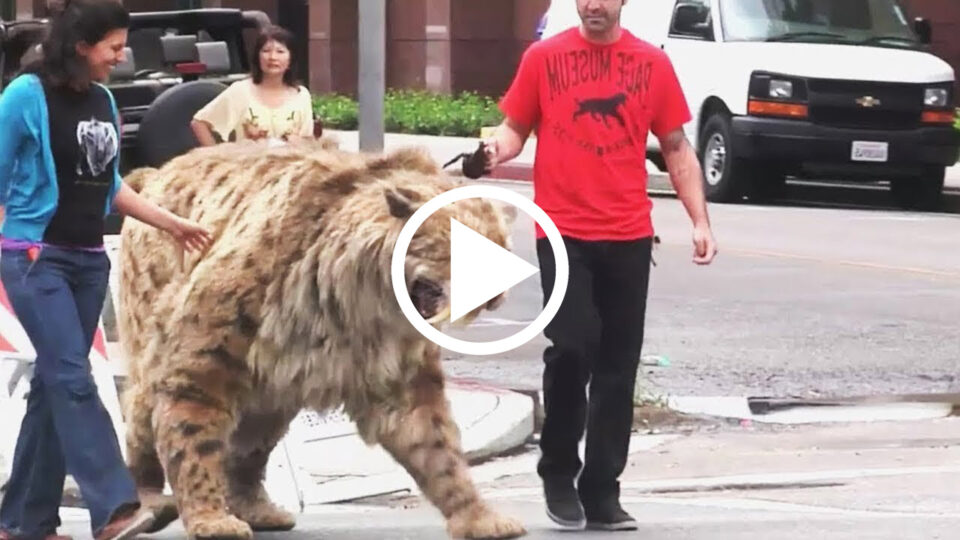Certain animals have disappeared forever because of many different reasons. Some of the causes include the ice age, man-hunting breeds for money to the point of annihilation, and climate and environmental changes have also managed to render certain species to the brink of extinction.
However, it comes as a surprise that certain species of animals may be returning from the dead.
Join us as we count down 15 animals that came back from extinction. It’s time to buckle up and lower your visor as we find out whose being raised from the dead.
Are you ready? Hold on… I think I just saw a T-REX in my backyard! 15 – The Smilodon – Number 15 on our list is the Smilodon. The Smilodon, better known as the Sabretooth Tiger and was a fierce predator thousand of years ago.
With huge fangs extruding from its mouth, the sabretooth was a sight to behold. Ten thousand years ago, tar pits were a natural and deadly feature of the landscape.
Animals became stuck and would sink into the asphalt and die. In the La Brea tar pits of California, scientists have recovered over a million bones. This includes one of the largest and best-preserved collections of sabertooth bones in the world.
Data collected from the La Brea tar pits helps scientists piece together the natural history of the area, including the history of the sabertooth cat. Scientists have learned that the sabertooth cat first appeared in the archaeological record two million years ago.
Sabertooths ranged widely throughout North and South America and are related to modern cats. However, no real descendants of the sabertooth cat are alive today, but scientists are thinking of a way to bring the big cat back.
If they are successful, the sabertooth may once again reign the lands of the world. 14 – Terror Skink Number 14 on our list is the Terror Skink. They thought the Terror Skink to be extinct for over 100 years before they rediscovered one in 2003.
Further individuals have been discovered in 2009 and 2013. They filmed the lizard and took its measurements before releasing it back into the wild where it lives on the uninhabited isle of Pines.
They had considered it extinct since only one person had ever seen an individual–in 1876. The teeth of The Terror Skink are long, curved, and sharp, suggesting predatory habits unusual for a large skink; most skinks are omnivorous.
Its diet might include larger invertebrates, other lizards, young birds, and eggs. It is about 20 inches long. It is presumed to be diurnal and mainly terrestrial, but maybe partially arboreal.
With such a small area of occupation, the terror skink is subject to threats such as habitat loss through a typhoon or wildfire, and the possibility of predatory animals being introduced to the island.
Hopefully, the Terror Skink can keep its generation going 13 – New Holland Mouse – Number 13 on our list is the New Holland Mouse.
Only found in Australia and Tasmania. They found a lost species of mice in a national park while on a hike near Sydney.
The New Holland The mouse is a small native rodent, similar in size and appearance to the introduced House Mouse.
It can be distinguished from the House Mouse by its dusky-brown tail which is longer than the rest of the body and darker on the dorsal surface, the absence of a notch on the upper incisors, and the absence of a distinctive ‘mousy’ odor.
The New Holland Mouse has a fragmented distribution across Tasmania, Victoria, New South Wales, and Queensland.
Genetic evidence shows that the New Holland Mouse once formed a single continuous population on the mainland Australia and the distribution of recent subfossils further suggest that the species has undergone a large range contraction since European settlement.
The total population size of mature individuals is now estimated to be less than 10,000 individuals although, given the number of sites from which the species has disappeared between 1999 and 2009, it is likely that the species’ distribution is actually smaller than current estimates.
Known to inhabit open heathlands, woodlands, and forests with a heathland under-story and vegetated sand dunes. It is a social animal, living predominantly in burrows shared with other individuals.


